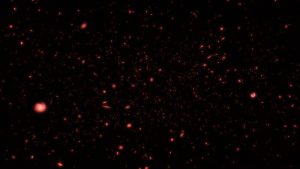
Once upon a time in the early universe, in theory at least, there was a time when our universe was made of hydrogen, helium, and trace amounts of lithium and beryllium. From this mixture, everything that we see today was formed, and among the first things to form, at least in theory, were stars made only of hydrogen, helium, and those trace amounts of lithium and beryllium. These chemically not-very-diverse stars are called population III stars, and people have been searching for them decades, and the story of when they must have lived and died has gotten more and more confusing the longer we have gone without finding them.
Here’s some background you need for this story to make sense. In general, massive stars live very short lives, and the most massive stars live the most briefly, with some stars counting the years in millions instead of billions. Tiny stars essentially live forever, with their nuclear-burning hearts continuing to churn for trillions of years. Since our universe is aged in the billions and not trillions, we would expect the most massive of the early stars to have died, and then – we used to think – the tiny ones should live on and on and on.
But no matter how hard people look, no proper composition, truly lacking heavy elements, stars have been found. So… we updated our theories. Now we have the added caveat that folks think that stars made of pretty much just H and He must be massive in all cases, and thus short-lived in all cases. This means we are now trying to chase down exactly how massive and how short-lived. Instead of trying to search for old small stars in our current universe, we’re searching for massive stars in time. Thanks to the finite speed of light, this is possible by looking at more and more distant objects whose light has been traveling for ever longer periods of time.
So far, still, no pop III stars have been found, and this is allowing us to narrow in on when they must be. In the latest attempt, astronomers using the Hubble Space Telescope have been unable to find pop III stars in data from when the universe was just 500 million years old. This means all the pop III stars had already formed and gone supernova within 500 million years in the observed systems. This new work was led by the European Space Agency’s Rachana Bhatawdeker and is published in the Monthly Notices of the Royal Astronomical Society based on observations in the direction of galaxy cluster MACSJ0416 taken with Hubble, Spitzer, and the Very Large Telescope.
The target of the observations weren’t the stars in this galaxy cluster, but rather they used this cluster’s gravity as a lens to get a better view of more distant background galaxies that can only be seen when gravity bends light that would otherwise go off in other directions to instead focus in our direction, thus increasing the light we receive from these faint sources. This is a fairly old technique called gravitational lensing, but for this paper, they used new processing methods that allowed them to discover smaller lensed galaxies than have been seen before. It was hoped that these smaller systems might have had slower star formation starts and may still have the elusive pop III stars forming and glowing. This was not found to be the case.
So… we now know with even greater certainty that these stars formed fast and died fast. And, now more than ever, we have to admit our best option for finding them will be the JWST if it ever launches.
More Information
Hubble Space Telescope news release
“Evolution of the galaxy stellar mass functions and UV luminosity functions at z=6−9 in the Hubble Frontier Fields,” Rachana Bhatawdekar et al., 2019 March 27, Monthly Notices of the Royal Astronomical Society (Preprint on arxiv.org)
New paper forthcoming from MNRAS




 Join the Crew!
Join the Crew!
 Escape Velocity Space News
Escape Velocity Space News
0 Comments